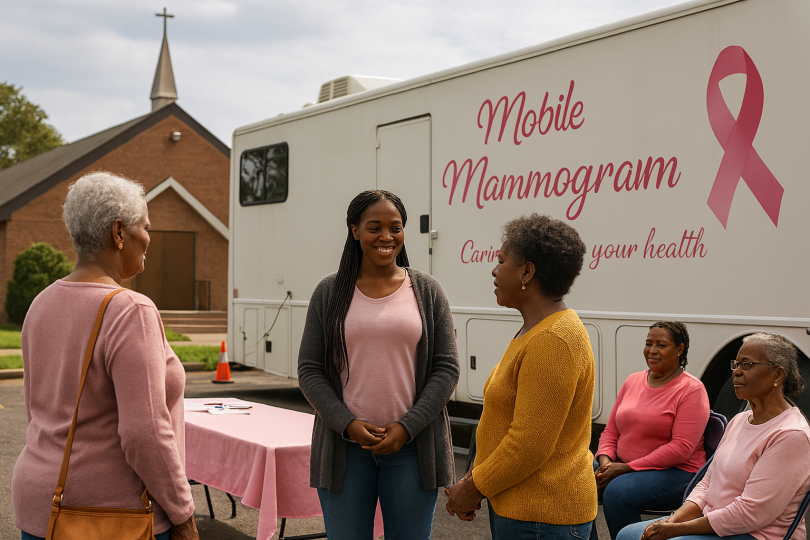Breast cancer remains one of the leading health challenges for women. The World Health Organization reports that 99% of breast cancer cases occur in women, and early detection can mean the difference between life and death.
Black women face serious challenges when it comes to breast cancer. They are often diagnosed at younger ages, in later stages, and with more aggressive types of the disease than white women. Even though the risks are higher, many Black women still have limited access to early screenings and support that speaks to their needs. Without regular mammograms, clear education, and strong healthcare guidance, these women are left more vulnerable to poor outcomes.
Yet, many women in Black communities face barriers in timely screening, limited access to hospitals, inadequate finances, and even mistrust of the healthcare system. Different reports from Walden University and the University of St Thomas point to these facts.
One powerful solution to reduce the number of lives lost is to expand community-based breast cancer screening programs that bring care closer to where Black women live, work, and worship. Making screening support available and accessible is not only about health; it’s about fairness, survival, and justice.
Let me walk you through strategies to consider when starting such programs.
1. Mobile Mammography Units
Access to healthcare is a significant issue. According to the Commonwealth Fund, 26 million people in the US do not have access to health coverage, and a disproportionate number are from the Black communities. The numbers are even higher when it comes to specialized imaging centers.
With a mobile mammography unit, we can provide a direct solution by bringing screening to our underserved neighborhoods. We can set up these mobile clinics in parking lots, near worship centers, grocery stores, or at any community event. These mobile units will make it possible for women to be screened without the cost and time of travelling long distances.
To find a mammography unit near you, contact your healthcare system, local hospital or healthcare provider. You can also get information online or from dedicated websites.
2. Affordable Care
No woman wants to die of breast cancer, and most would welcome screening, but cost has too often been a barrier. According to a report in the National Library of Medicine, more than half of underserved Black women identify cost as a significant obstacle to mammography screening. In the US, women on Government assistance/insurance can have routine screenings from age 40, while those above 40 can have a mammogram biannually. Earlier and more frequent screening may be recommended for women with higher risk factors.
A successful breast cancer screening program must address the issue of affordability. Through community effort, we can partner with a non-profit organization to offer free or low-cost screenings and help Black women navigate insurance coverage. Affordable care means no Black woman is left behind because of financial constraints.
3. Partnership with Stakeholders
SCIRP identified a lack of information as a significant barrier to cancer treatment. However, it is not just about making information available but also about providing information from trusted sources. Our worship centers and local centers are trusted gathering places.
Partnering with these organizations for awareness events and on-site screenings will be a significant win. It will help build trust and encourage participation. Imagine hosting a health day after a Sunday service with the Pastor encouraging Black sistas to participate in breast cancer screening, it will make the process easier and less intimidating.
4. Cultural Tailored Messaging
Generic health campaigns have had little impact in our community. In fact, we often don’t trust them. 51% of Blacks in America already believe that the US healthcare system is designed to hold us back, according to the Pew Research Center. Racism and mistreatment at the hands of health workers are at the core of this mistrust.
However, the program can make a significant difference by using language, outreach strategies, and imagery that resonate with women in our community. Using Black women who understand our suffering in media and flyers can build trust and relevance.
5. Peer Navigators
For many women, navigating the route of breast cancer screening and treatment can feel overwhelming. However, peer navigators can train survivors and community health workers to offer guidance and emotional support to Black women. These trained individuals, who have survived breast cancer, can serve as a bridge to guide and support you. Here’s how they help:
- Scheduling appointment
- Understanding results
- Connecting with a resource
- Emotional support
- Empowering women to take action
Personal touch like this can increase follow-through and reduce fear.
Build Health Equity Through Community Action
According to a 2025 report by the American Cancer Society, it is estimated that about 42,170 women will die this year. But community-based breast cancer screening programs help to save lives by closing gaps between needs and access by leveraging trusted community spaces.
At Elevate Black Health, we believe that bringing screening and treatment services closer to the Black neighborhood, along with personal guidance and tailored cultural needs, would make it easier for more women to be screened early.
Let’s remember, collective effort is the bedrock that can help transform breast cancer outcomes and move us closer to health equity.
Visit these sites to learn more:
- Breast cancer. https://www.who.int/news-room/fact-sheets/detail/breast-cancer
- Barriers to Breast Cancer Prevention and Screening among African American Women. https://scholarworks.waldenu.edu/cgi/viewcontent.cgi?article=3082&context=dissertations
- “Girl, just pray .”: Factors That Influence Breast and Cervical Cancer Screening Among Black Women in Rochester, MN. https://researchonline.stthomas.edu/view/pdfCoverPage?instCode=01CLIC_STTHOMAS&filePid=13439823960003691&download=true
- The State of Health Insurance Coverage in the U.S. https://www.commonwealthfund.org/publications/surveys/2024/nov/state-health-insurance-coverage-us-2024-biennial-survey
- Cost as a barrier to screening mammography among underserved women. https://pmc.ncbi.nlm.nih.gov/articles/PMC4465254/
- Screening for Breast Cancer. https://www.cdc.gov/breast-cancer/screening/index.html
- Perceptions and Receipt of Cancer Screening among African Americans: A Community Networks Program Project. https://www.scirp.org/journal/paperinformation?paperid=72228
- October Health: Black Women and Breast Cancer Awareness. https://www.elevateblackhealth.com/october-health-black-women-and-breast-cancer-awareness/
- February Health: Cancer Prevention Month Campaign. https://www.elevateblackhealth.com/february-health-cancer-prevention-month-campaign/
- Black Americans and Mistrust of the US Healthcare System and Medical Research. https://www.pewresearch.org/race-and-ethnicity/2024/06/15/black-americans-and-mistrust-of-the-u-s-health-care-system-and-medical-research/
- Key Statistics for Breast Cancer. https://www.cancer.org/cancer/types/breast-cancer/about/how-common-is-breast-cancer.html
- Breast Cancer in Black Women: Disparities and Need for Early Screening. https://www.elevateblackhealth.com/breast-cancer-in-black-women-disparities-and-need-for-early-screening/








